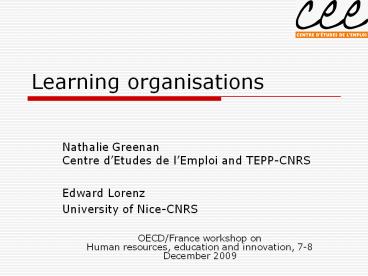Learning organisations - PowerPoint PPT Presentation
1 / 17
Title:
Learning organisations
Description:
Learning organisations Nathalie Greenan Centre d Etudes de l Emploi and TEPP-CNRS Edward Lorenz University of Nice-CNRS OECD/France workshop on – PowerPoint PPT presentation
Number of Views:40
Avg rating:3.0/5.0
Title: Learning organisations
1
Learning organisations
Nathalie Greenan Centre dEtudes de lEmploi and
TEPP-CNRS Edward Lorenz University of Nice-CNRS
OECD/France workshop onHuman resources,
education and innovation, 7-8 December 2009
2
Outline
- What is a learning organisation?
- A quantitative assessment at the European level
based on the EWCS?The spread of learning
organisations?The trend in work complexity - Policy issues
3
What is a learning organisation? (1)
- An organisation able to adapt and compete at low
cost through learning - Common definitional ground
- ? multi-level concept individual-team-organisati
on - ? role of learning cultures beliefs, norms and
values supportive of employee learning - ? specific HRM policies supportive of learning
culture
4
What is a learning organisation? (2)
- Tradeoffs in organisational design
- ? stimulate dynamic properties / provide
stability in the organisational structure - ? standardisation/routine versus mutual
adjustement/innovation - Scientific and technical skills
- deal with an employee participation contraint to
innovation in order to avoid conflicts between
vested interest in the organisation ?
characteristics of the innovative idea ?
socio-demographic characteristics of the
workforce ? soft skills ? group processes ?
customer focus ? transparency and fairness
5
The spread of learning organisations in the EU-15
(1)
Source EWCS 2000
6
The spread of learning organisations in the EU-15
(2)
Source EWCS 2000
7
Learning organisations and innovation mode(1)
- Countries with a high proportion of learning
forms of work organistion have more lead
innovators higher in-house creative capacity - Countries where lean and taylorist forms of work
organisation dominate have more non-innovators
and technology adopters more reliance on outside
suppliers of new technology
8
Learning organisations and innovation mode (2)
9
Learning organisations, HRM and organisational
culture
Source EWCS 2005
10
Learning organisations in public and private
sectors in EU-27
Source EWCS 2005
11
The complexity paradox (1)
- 4 core characteristics of complex work
- Complex tasks
- Learn new things
- Choose or change the order or tasks
- Choose or change the methods of work
Source EWCS 1995, 2000 and 2005
12
The complexity paradox (2)
Source EWCS 1995, 2000 and 2005
13
The complexity paradox (3)
- Work complexity has all the more decreased that
forces are present that should contribute to its
development ICT diffusion, growing experience
and education, development of the service sector - Increasing heterogeneity across EU-15 evidence
of a country effect in this trend - Objective reasons? standardisation?
polarisation - Subjective reasons? overqualification?
organisational changes
14
Policy issues Innovation
- The bottleneck to improving the innovative
capabilities of European firms might not be low
levels of RD expenditures, which are strongly
determined by industry structures and
consequently difficult to change, but the
widespread presence of working environments that
are unable to provide a fertile environment for
innovation. - If this is the case, then the next step for
European policy is to encourage the adoption of
pro-innovation organisational practice,
particularly in countries with poor innovative
performance.
15
Policy issue Training
- At the individual level, further training is
positively correlated with learning and lean
forms of organisation - Institutional set-up matters a mobile workforce
and labour market policies emphasising
expenditures in further training favour learning
types of jobs - Could a lack of intermediate skills acquired in
vocational education and further training create
a learning bottleneck and favour more
standardised organisations? - Need to target further training policies on part
time and precarious workers
16
Policy issue HRM practices
- evaluation practices, employment security and pay
system based on collective performance are
positively correlated with learning and lean
types of jobs - Learning cultures mediates the impact of HRM
variables on the likelihood of employee learning - HRM policies probably play a role in mitigating
conflicts in change situation - Need to identify best HRM practices conditional
on innovation patterns and institutional settings
17
Conclusion measurement issue
- Indicators for innovation need to do more than
capture material inputs such as RD expenditures
and the available pool of technical and
scientific skills. Indicators also need to
capture how these material and human resources
are used and whether or not the work environment
promotes the further development of the knowledge
and skills of employees. - Need for more data to inform evidence based
policy taking into account the interaction
between institutions, learning models of
organisation and innovation patterns. - A survey instrument linking information from
employers with information from employees would
allow to build a rich set of indicators for
scoreboards as well as conducting research giving
analytical insights to set hard facts into
context.































